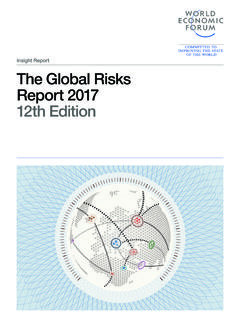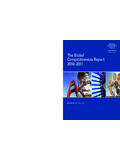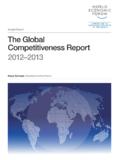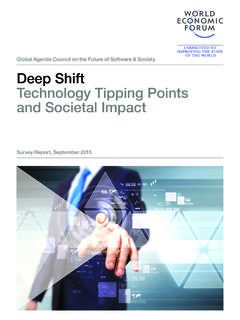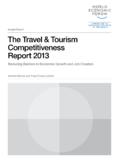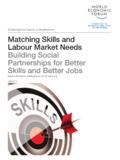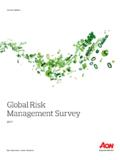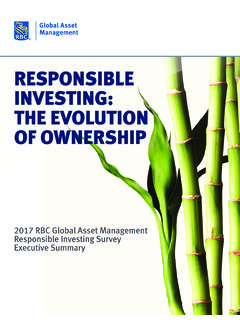Transcription of The Global Risks Report 2018 13th Edition
1 Insight Report The Global Risks Report 2018. 13th Edition The Global Risks Report 2018, 13th Edition , is published by the World Economic Forum. The information in this Report , or on which this Report is based, has been obtained from sources that the authors believe to be reliable and accurate. However, it has not been independently verified and no representation or warranty, express or implied, is made as to the accuracy or completeness of any information obtained from third parties. In addition, the statements in this Report may provide current expectations of future events based on certain assumptions and include any statement that does not directly relate to a historical fact or a current fact. These statements involve known and unknown Risks , uncertainties and other factors which are not exhaustive. The companies contributing to this Report operate in a continually changing environment and new Risks emerge continually. Readers are cautioned not to place undue reliance on these statements.
2 The companies contributing to this Report undertake no obligation to publicly revise or update any statements, whether as a result of new information, future events or otherwise and they shall in no event be liable for any loss or damage arising in connection with the use of the information in this Report . World Economic Forum Geneva World Economic Forum . 2018 All rights reserved. All rights reserved. No part of this publication may be reproduced, stored in a retrieval system, or transmitted, in any form or by any means, electronic, mechanical, photocopying, or otherwise without the prior permission of the World Economic Forum. ISBN: 978-1-944835-15-6. REF: 09012018. The Report and an interactive data platform are available at World Economic Forum 91-93 route de la Capite CH-1223 Cologny/Geneva Switzerland Tel.: +41 (0) 22 869 1212. Fax: +41 (0) 22 786 2744. Global Risks Landscape Figure I: The Global Risks Landscape 2018. Weapons of mass destruction Extreme weather events Natural disasters Failure of climate-change mitigation and adaptation Water crises Cyberattacks Biodiversity loss and Food crises ecosystem collapse Large-scale involuntary migration Spread of infectious Interstate conflict diseases Man-made environmental disasters Critical information average Profound social infrastructure breakdown instability Failure of national governance Fiscal crises Terrorist attacks Unemployment or Failure of regional or underemployment Global governance Data fraud or theft Asset bubbles in a major economy Failure of critical State collapse or crisis infrastructure Failure of financial Energy price shock mechanism or institution Adverse consequences of Failure of urban planning technological advances Impact Illicit trade Unmanageable inflation Deflation plotted area average Likelihood Top 10 Risks in terms of Top 10 Risks in terms of Likelihood Impact 1 Extreme
3 Weather events 1 Weapons of mass destruction Categories 2 Natural disasters 2 Extreme weather events Economic 3 Cyberattacks 3 Natural disasters 4 Data fraud or theft 4 Failure of climate-change mitigation and adaptation Environmental 5 Failure of climate-change mitigation and adaptation 5 Water crises 6 Large-scale involuntary migration 6 Cyberattacks Geopolitical 7 Man-made environmental disasters 7 Food crises 8 Terrorist attacks 8 Biodiversity loss and ecosystem collapse Societal 9 Illicit trade 9 Large-scale involuntary migration Technological 10 Asset bubbles in a major economy 10 Spread of infectious diseases Source: World Economic Forum Global Risks Perception Survey 2017 2018. Note: Survey respondents were asked to assess the likelihood of the individual Global risk on a scale of 1 to 5, 1 representing a risk that is very unlikely to happen and 5 a risk that is very likely to occur. They also assess the impact on each Global risk on a scale of 1 to 5 (1: minimal impact, 2: minor impact, 3: moderate impact, 4: severe impact and 5: catastrophic impact).
4 See Appendix B for more details. To ensure legibility, the names of the Global Risks are abbreviated; see Appendix A for the full name and description. Figure II: The Risks -Trends Interconnections Map 2018. Trend Interconnection Map Rising chronic diseases Increasing national sentiment Changing climate Changing climate Changing landscape of international governance Biodiversity loss and ecosystem collapse Man-made environmental Natural disasters Degrading environment disasters Food crises Extreme weather events Spread of infectious Energy price shock diseases Failure of climate-change Shifting power Water crises mitigation and adaptation Large-scale involuntary migration Interstate conflict Failure of urban planning Weapons of mass destruction Failure of regional or State collapse or crisis Global governance Rising urbanization Profound social Failure of national governance instability Failure of critical Terrorist attacks Unmanageable inflation infrastructure Unemployment or Adverse consequences of underemployment Critical information technological advances Increasing polarization infrastructure breakdown of societies societies
5 Cyberattacks Deflation Illicit trade Fiscal crises Growing middle class in emerging economies Data fraud or theft Asset bubbles in a major economy Failure of financial mechanism or institution Rising income and wealth disparity Rising geographic mobility Rising geographic mobility Ageing population Rising cyber dependency Rising cyber dependency Risks Trends Economic Geopolitical Technological Risks Risks Risks Number and strength Number and strength Environmental Societal of connections of connections Risks Risks ( weighted degree ) ( weighted degree ). Source: World Economic Forum Global Risks Perception Survey 2017 2018. Note: Survey respondents were asked to select the three trends that are the most important in shaping Global development in the next 10 years. For each of the three trends identified, respondents were asked to select the Risks that are most strongly driven by those trends. See Appendix B for more details. To ensure legibility, the names of the Global Risks are abbreviated; see Appendix A for the full name and description.
6 Risk Interconnection Map Figure III: The Global Risks Interconnections Map 2018. Biodiversity loss and ecosystem collapse Man-made environmental disasters Food crises Natural disasters Extreme weather events Energy price shock Spread of infectious Failure of climate-change diseases Water crises mitigation and adaptation Large-scale involuntary migration Interstate conflict Failure of urban planning Weapons of mass destruction State collapse or crisis Failure of regional or Global governance Profound social Terrorist attacks instability Failure of critical Failure of national infrastructure governance Unmanageable inflation Unemployment or underemployment Adverse consequences of technological advances Critical information Cyberattacks infrastructure breakdown Illicit trade Fiscal crises Deflation Data fraud or theft Asset bubbles in a major economy Failure of financial mechanism or institution Economic Geopolitical Technological Risks Risks Risks Number and strength Environmental Societal of connections Risks Risks
7 ( weighted degree ). Source: World Economic Forum Global Risks Perception Survey 2017 2018. Note: Survey respondents were asked to identify between three and six pairs of Global Risks they believe to be most interconnected. See Appendix B for more details. To ensure legibility, the names of the Global Risks are abbreviated; see Appendix A for the full name and description. Figure IV: The Evolving Risks Landscapes, 2008 2018. Top 5 Global Risks in Terms of Likelihood 2008 2009 2010 2011 2012 2013 2014 2015 2016 2017 2018. Asset price Asset price Asset price Storms and Severe income Severe income Income disparity Interstate conflict Large-scale Extreme weather Extreme weather 1st collapse collapse collapse cyclones disparity disparity with regional involuntary events events consequences migration Breakdown of critical information infrastructure Middle East Slowing Chinese Slowing Chinese Flooding Chronic fiscal Chronic fiscal Extreme weather Extreme weather Extreme weather Large-scale Natural disasters 2nd instability economy (<6%) economy (<6%)
8 Imbalances imbalances events events events involuntary migration Failed and failing Chronic disease Chronic disease Corruption Rising greenhouse Rising greenhouse Unemployment Failure of national Failure of climate- Major natural Cyberattacks 3rd states gas emissions gas emissions and governance change mitigation disasters underemployment and adaptation Breakdown of critical information Oil and gas price Global governance infrastructure Fiscal crises Biodiversity loss Cyber attacks Water supply Climate change State collapse or Interstate conflict Large-scale Data fraud or theft 4th spike gaps crises crisis with regional terrorist attacks consequences Chronic disease, Retrenchment Global governance Climate change Water supply Mismanagement Cyber attacks High structural Major natural Massive incident Failure of climate- 5th developed world from globalization gaps crises of population unemployment or catastrophes of data fraud/theft change mitigation (emerging) ageing underemployment and adaptation Top 5 Global Risks in Terms of Impact 2008 2009 2010 2011 2012 2013 2014 2015 2016 2017 2018.
9 Asset price Asset price Asset price Fiscal crises Major systemic Major systemic Fiscal crises Water crises Failure of climate- Weapons of mass Weapons of mass 1st collapse collapse collapse financial failure financial failure change mitigation destruction destruction and adaptation Breakdown of critical information infrastructure Retrenchment Retrenchment Retrenchment Climate change Water supply Water supply Climate change Rapid and massive Weapons of mass Extreme weather Extreme weather 2nd from globalization from globalization from globalization crises crises spread of destruction events events (developed) (developed) (developed) infectious diseases Slowing Chinese Oil and gas Oil price spikes Geopolitical Food shortage Chronic fiscal Water crises Weapons of mass Water crises Water crises Natural disasters 3rd economy (<6%) price spike conflict crises destruction imbalances Breakdown of critical information Oil and gas Chronic disease infrastructure Chronic disease Asset price Diffusion of Unemployment Interstate conflict Large-scale Major natural Failure of climate- 4th price spike collapse imbalances weapons of mass and with regional involuntary disasters change mitigation destruction underemployment consequences migration and adaptation Pandemics Fiscal crises Fiscal crises Extreme energy Extreme volatility Failure of climate- Critical information Failure of climate- Severe energy Failure of climate- Water crises 5th price volatility in energy and change mitigation infrastructure change mitigation price shock change mitigation agriculture prices and adaptation breakdown and adaptation and adaptation Economic Environmental Geopolitical Societal Technological Source: World Economic Forum 2008 2018, Global Risks Reports.
10 Note: Global Risks may not be strictly comparable across years, as definitions and the set of Global Risks have evolved with new issues emerging on the 10-year horizon. For example, cyberattacks, income disparity and unemployment entered the set of Global Risks in 2012. Some Global Risks were reclassified: water crises and rising income disparity were re-categorized first as societal Risks and then as a trend in the 2015 and 2016 Global Risks Reports, respectively. The Global Risks Report 2018. 13th Edition Strategic Partners Marsh & McLennan Companies Zurich Insurance Group Academic Advisers National University of Singapore Oxford Martin School, University of Oxford Wharton Risk Management and Decision Processes Center, University of Pennsylvania Contents Preface 5. By Klaus Schwab and B rge Brende Executive Summary 6. Global Risks 2018: Fractures, Fears and Failures 8 Economic Storm Clouds 18 Future Shocks 25 Grim Reaping A Tangled Web The Death of Trade Democracy Buckles Precision Extinction Into the Abyss Inequality Ingested War without Rules Identity Geopolitics Walled Off Geopolitical Power Shifts 36.
